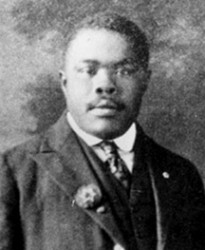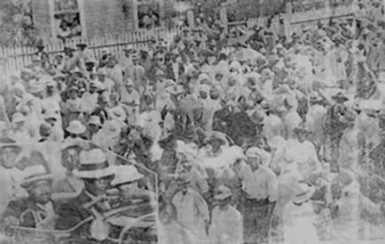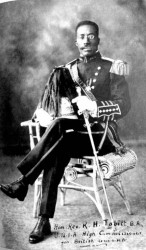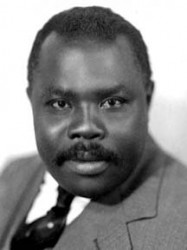By Nigel Westmaas
This year marks the 100th anniversary of the founding of the United Negro Improvement Association (UNIA) which had a profound influence on peoples of African descent, not only in the United States, but also in what were then colonial territories like Guyana. Today historian Nigel Westmaas reflects on the movement in this country.
A familiarity with Marcus Garvey and his Universal Negro Improvement Association’s (UNIA) impact and role in British Guiana (Guyana) is notably absent from the general popular imagination, as well as from the education syllabuses and historiogaphy of this country. This is especially so as it applies to that crucial period of the 1920s and 1930s. The Jamaican born Garvey had achieved fame and notoriety in the USA, his main base in the emergent years of his UNIA. Co-founded in 1914 in Jamaica by Marcus Garvey and Amy Ashwood, his future spouse, the UNIA went on to become the largest pan-African organisation in history, with a membership of four million plus at its height. By 1926 the UNIA had grown to 725 branches in the United States and 300 plus abroad.

The UNIA’s ideological and organisational flexibility, its race consciousness, anti-racism, ideas of statehood and independence and African redemption; its anti-colonialism and Pan-Africanism and support of Ethiopianism; its support of labour and social struggles; in short its immense global role in the 1920s and 1930s gave the organisation an important and influential worldwide presence.
The founding statement of the Guyana UNIA as reported in the Daily Chronicle in April 20, 1919 provides a glimpse of the organisation’s local support base. The article reports announcing the “…inauguration of a branch of an American Society known as ‘The Universal Negro Improvement Association and African Communities League of Georgetown.’” The same report highlighted the “fair attendance of clerks, mechanics and porters” at the first meet. The reported purpose of the local UNIA was “to establish fraternity among the members of the Negro race in the colony.” At its maximum strength the UNIA reached a total of seven groups scattered geographically across colonial Guyana with a combined average membership of two hundred. Identified UNIA branches included those in Charlestown, Lacytown, Parika, Pomeroon and Vergenoegen. While the Guyana UNIA was numerically slight compared to approximately thirty UNIA groups in Trinidad & Tobago and fifty-two in Cuba, the Garvey organization made a distinct but largely unacknowledged imprint on social and political life in British Guiana.
‘Global vision’
In sync with its global vision the UNIA emerged in the colony with already identified goals. Among those objectives was the “confraternity among the race; to promote a spirit of race pride and love; to reclaim the fallen of the race; to administer and assist the needy; to establish commissaries or agencies in the principal countries of the world for the Protection of all Negroes, irrespective of nationality.”
In its Guyana activity the UNIA managed, as local witness to its global political character, to immerse itself in a number of activities consistent with its counterparts elsewhere. For instance, the UNIA cooperated with churches like the Jordanites, and with black organizations, held sewing classes, prepared religious elocution contests, sent messages to the Indian anti-colonial movement and celebrated and defended the state of Ethiopia when the Italians invaded in 1935. These actions, in conjunction with its well-known and continual support for labour gave the British Guiana UNIA a consistent visibility. But it too faced its share of repression as it tried to insert itself into the political and community action in the colony. It navigated representation of both conservative and radical ideals and political practice, given territory and context. In Guyana’s case the UNIA’s radical impulses were more suited for British Guiana with labour on the rise.
Colonial alarm

In the first quarter of the twentieth century even these relatively moderate goals were frightening to the colonial order, especially as intelligence reports circulated between North America and the British Empire highlighting the speed and growth of the UNIA. The British Guiana Inspector-General of Police expressed alarm: “For the past five years Garvey’s disciples have been preaching in the colony… the germ of racial prejudice has undoubtedly taken root in the Negro and perhaps to a lesser degree the East Indian sections of the community.”
As an aspect of colonial alarm Garvey’s Negro World newspaper was banned, but not before copies appeared in the bookshop owned by AA Thorne, the black legislator, journalist and labour leader. The UNIA would petition Major EFL Wood, the British Undersecretary of State for the Colonies with the purpose of both allaying British concern about its (UNIA) activity in Guyana and requested a lifting of the ban on its periodical. The petition argued that the prohibition of the Negro World newspaper was “illegal, and therefore an infringement of our rights and privileges as loyal British Subjects.” This apparently deferential terminology in the appeal has to be seen in the context of the power of the hegemony of the Victorian era in the colonies and the contradictory consciousness of “Britishness.” As one writer states, “West Indians and Guyanese regularly denounced the actions of local administrators while idealizing Victoria and her heirs as the embodiment of egalitarian imperialism.” In spite of these accommodations to colonial authorities Garvey regularly denounced imperialism and was bold enough to dispatch a letter of condolence to Moscow expressing regret at the 1924 death of Lenin deeming him “probably the world’s greatest man.”
Black nationalist groups
The UNIA was not the only “black conscious” group to emerge in twentieth century Guyana nor would it be the last. Other embryonic local and Pan-African black groups included the British Guiana African Association, Negro Progress Convention (NPC), African Blood Brotherhood (ABB), British Guiana Afro-Improvement Association, New Negro Development Association, League of Coloured Peoples (LCP), the African Development Association, and much later, in the 1960s, the African Society for Cultural Relations with Independent Africa (ASCRIA). In even more modern times we witnessed the emergence of ACDA, the 1823 Committee and the Cuffy 250 Committee.
In the Garvey era some of these groups were more significant than others in respect of impact on national life. The British Guiana Afro-Improvement Association for instance, was established in 1901, but little information on its activity is available in the public record.

The ABB founded by Cyril Briggs (born in Nevis) and other residents of the Caribbean was an independent black organisation with strong links to the world communist movement. In 1921, the ABB and UNIA held a joint mass public meeting in Georgetown, although there were serious differences in the United States between the two organizations and the ABB was accused of “poaching” on the UNIA’s mass following in the USA.
The African Development Association materialized in 1924. At its height it held an average membership of thirty men and ten women. Its founding motto declared for charity activities and “to develop talent, advocate self-help and a school for Juveniles and adults of African descent.” But by far the two most prominent of the black conscious groups in Guyana, one potentially able to ‘compete’ with the UNIA at the time were the NPC and the LCP. Established in British Guiana in 1922 for the cultural and social development of African Guyanese, the NPC at its height had assembled forty branches throughout Guyana. Its self-proclaimed mission was to “perpetuate Negro solidarity and to create, organize, provide means and build institutions that the executive committee may consider desirable to assist Negroes in the development of self-help, self-reliance and independence.”
UNIA and BGLU
The UNIA’s activity and solidarity with union struggles and its fight against racism around the world made it a natural ally of labour’s efforts and provoked trepidation in the plantocracy and the Crown. In January 1919 the British Guiana Labour Union (BGLU) was created and its founder Hubert Critchlow was engaged on a full-time basis with its administration and activity, and by 1922 attracted a relatively large membership. Expectedly, the BGLU was involved in a number of labour disputes but did not confine itself to labour issues. When the economic fortunes of the colony declined seriously in 1922 the BGLU and the UNIA held a “mass meeting at the Parade Ground to protest the cuts and the payments of higher rents.” The UNIA for its part was also known to hold “dinners” for the poor in the colony.
Slight as its organizational roots were, it was evident that the activities of the UNIA made the authorities wary. This was confirmed by the fact that the Special Branch was “required to report on the activities of its members.” The alliance established by the BGLU and UNIA would extend into the 1930s. So close was the relationship between the two organisations that union leaders made a point of inviting the UNIA to its main official functions. On the third anniversary of the BGLU in 1922 it was noted that “Dr Tobit [sic] and other representatives of the Universal Negroes Improvement Association were in attendance.” The reference here was to Reverend RH Tobitt, the UNIA High Commissioner to British Guiana (also UNIA High Commissioner to Great Britain). Later, during the ‘Ruimveldt Incident’ in 1924 the UNIA, along with the BGLU, were held up by the authorities as the chief organizational suspects of the labour unrest that occurred there.
Garvey visits Guyana, 1937

Garvey’s visit to British Guiana in October 1937 was unquestionably the high point of the presence and activity of the UNIA in Guyana, and his visit was an important and expectant moment for the citizens of Georgetown, many of whom turned out in large numbers to witness his arrival on the Georgetown docks. There was at least one previous attempt by the President-General of the UNIA to visit the colony in 1921. But it was clear from the diplomatic correspondence between British governors in Guyana and Jamaica, that he would have been detained had he set foot in the colony that year.
During his address at the UNIA convention in Georgetown, Garvey lauded the twenty years of UNIA activity around the world. He described it as “the most powerful and useful organization in the interest of the race,” one that had been “responsible for that world consciousness that had come to every Negro.” To loud applause, Garvey ended his speech declaring that he would “take away the kindliest thoughts of British Guiana.” Markedly absent from the President-General’s remarks was any direct political reference to the socio-political situation in Guyana. Perhaps the overall rationale for this caution was tactical, an agreement allowing Garvey to land.
In the 1930s the internationalization of the black struggle was at times co-existent with Pan-Africanism and the Garveyites were more prepared than any other organization to relate and conflate local and international issues, including one of the most significant for blacks globally, the Italian invasion of Ethiopia in 1935. Such was the importance of the Ethiopian situation in the local consciousness that in 1936, a Guyanese, James Alexander Harto, the chief mechanic of Haile Selassie came back to a “throng of admiring relatives and friends …to give the ‘inside dope’ on the Italo-Ethiopian war.” Another Guyanese Simon Moore, an engineer of Sprostons Ltd even “secured an appointment as chief engineer” on Garvey’s SS Yarmouth of the Black Star Line steamer.
Decline
After the Second World War the UNIA continued to function even if not at the pre-war levels. Garvey passed on in 1940 but there was evidence of the group’s presence and activity in Guyana in the aftermath of the leader’s demise and the organization’s decline in Guyana and elsewhere. In 1950, in a kind of replay of the Garvey visit of 1937, the LCP arranged the visit of a Nigerian Prince Eze Ogueri to the colony. As with the Garvey visit, the arrival of the “first African dignitary to visit Guyana publicly and be exposed to the descendants of Africa and the general public” motivated a massive turnout of African Guyanese.
Even after the 1950s other black groups and individuals kept Garveyism in name and memory and even organizational form. These moments and segments of activity and memory confirmed the existence of the UNIA decades after the period of its paramount influence. For example, a UNIA Friendly Society was still active in the village of Victoria in the 1970s, and there was the presence of Garvey memorabilia and images inside the homes of African Guyanese. Moreover the colours of the flag of one political party, the PNC, might have emerged from or been influenced by the UNIA’s red, black and green. The Rastafarian movement in Guyana also maintained, like its formation elsewhere, the emblematic fusion between Garveyism and Ethiopianism, as evident in the invariably visible images of Garvey in Rastafarian flags and attire.
In sum, the UNIA’s Guyana sojourn was one link in its remarkable impact in the Caribbean, Africa, the Americas and the world, and affirms the conclusion that Garvey’s UNIA was the “largest and most powerful black nationalist organization the world has ever known.”




